The annals of art history are filled with celebrated figures whose lives and works are meticulously documented. Yet, they also contain individuals whose identities are shrouded in ambiguity, their contributions obscured by the passage of time or confusion with namesakes. Frederick E.J. Goff presents such a case. Research into this name reveals a complex tapestry woven with threads leading to different prominent individuals, making the task of isolating the painter a significant challenge for the art historian. The available information often conflates the potential artist with other notable figures, demanding careful navigation to approach a clearer understanding.
Initial inquiries frequently lead to individuals who, while significant in their own right, were not painters. Understanding who Frederick E.J. Goff wasn't is a crucial first step. This clarification helps to clear the path towards identifying the artist, or at least the most plausible candidate fitting that description, allowing for a more focused exploration of their potential life, work, and place within the artistic landscape of their time.
The Challenge of Identity: Unraveling the Goffs
One prominent figure often encountered is Frederick R. Goff (1914–1982). He was a highly respected American librarian and bibliographer, particularly renowned for his work on incunabula – books printed before 1501. His monumental achievement was the compilation and editing of Incunabula in American Libraries: A Third Census (1964), often simply referred to as "Goff." This work remains a cornerstone reference for scholars, librarians, and collectors studying early printed books.
Frederick R. Goff served as the Chief of the Rare Book Division at the Library of Congress for many years, contributing significantly to the understanding and preservation of early printing history. His expertise lay firmly within the realm of bibliography and library science. While his contributions to scholarship are undeniable, he was definitively not a painter, and his life and work belong to a different field of cultural history. Confusing him with an artist of a similar name obscures the distinct nature of his important legacy.
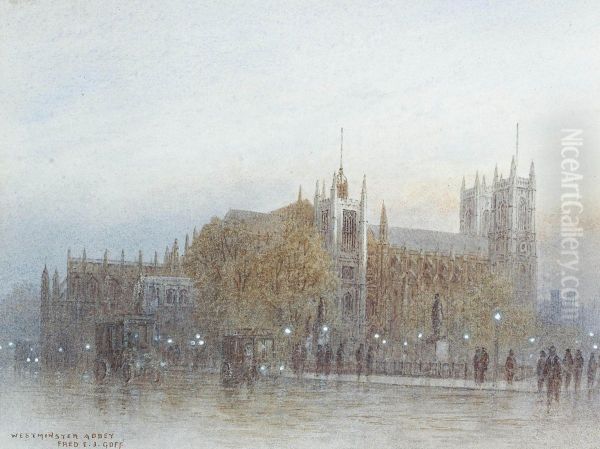
Another source of confusion arises with Frederick Harris Goff (1858–1923). This Frederick Goff was a prominent American banker and lawyer based in Cleveland, Ohio. He is best remembered as the visionary founder of the Cleveland Foundation in 1914, the world's first community foundation. This innovative philanthropic model aimed to pool charitable resources for the long-term benefit of the community, a concept that has since been replicated globally.
Frederick H. Goff's career was rooted in finance, law, and civic leadership. He served as president of the Cleveland Trust Company and was deeply involved in the civic life of his city. His legacy lies in the field of philanthropy and community development. Like Frederick R. Goff, his profession was far removed from the visual arts, and attributing artistic endeavors to him is inaccurate. Recognizing his distinct identity is essential to avoid misdirecting the search for the painter.
Given the prominence of the bibliographer and the banker, and the relative scarcity of readily available information on a painter named Frederick E.J. Goff, it becomes necessary to consider other possibilities. Research suggests the most plausible candidate for an artist with this name active in a relevant period might be Frederick John Goff (1855–1931). This British artist specialized in landscapes and cityscapes, particularly etchings and watercolors of London and its surroundings. While the middle initial differs ("John" vs. "E.J."), the overlap in name and profession makes him a strong possibility, especially considering the potential for transcription errors or variations in naming conventions over time. For the purpose of exploring the painter, we will focus on Frederick John Goff, while acknowledging the initial ambiguity presented by the name "Frederick E.J. Goff."
Frederick John Goff: A Life in Landscape
Frederick John Goff was born in Britain in 1855 and died in 1931. His artistic career unfolded during a period of significant change and dynamism in the British art world – the late Victorian and Edwardian eras, extending into the early 20th century. Unlike some of his more revolutionary contemporaries, Goff appears to have worked primarily within the established traditions of British landscape and topographical art, finding his niche in capturing the specific character of places, most notably London.
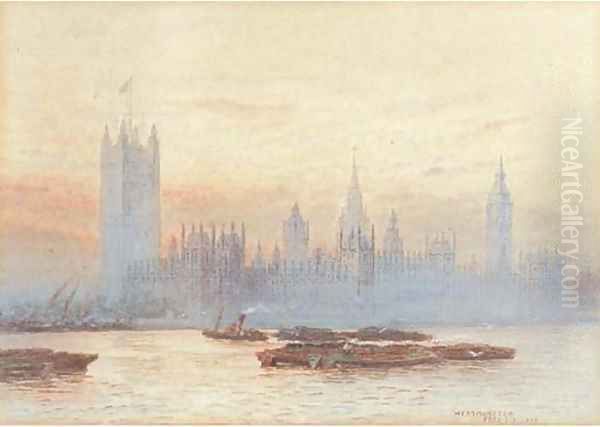
Information about his personal life and training remains somewhat limited compared to artists who achieved greater fame or notoriety. However, his body of work, particularly his etchings, suggests a dedicated and skilled practitioner. He exhibited his works, indicating participation in the professional art scene of his time, likely through venues such as London galleries or perhaps even submitting to larger exhibitions. His focus on recognizable locations suggests a market for views that appealed to residents, tourists, and collectors interested in depictions of the capital and scenic landscapes.
Goff's lifespan placed him amidst a generation grappling with the legacy of Romanticism, the detailed observation of the Pre-Raphaelites, and the incoming tide of Impressionism from across the Channel. Artists of his time navigated these currents, choosing paths that ranged from staunch academicism to radical experimentation. Goff seems to have charted a course closer to tradition, valuing draftsmanship and accurate representation, yet his work sometimes shows a sensitivity to light and atmosphere that hints at an awareness of newer artistic trends.
His specialization in etching also places him within a revival of interest in the medium as an original art form during the late 19th and early 20th centuries, often referred to as the Etching Revival. This movement saw artists exploring the expressive potential of line and tone offered by etching, moving beyond its earlier primary function as a reproductive technique. Goff's participation in this suggests an engagement with contemporary artistic practices and markets.
Artistic Style and Influences
Frederick John Goff's artistic style is best characterized by his commitment to topographical accuracy combined with an atmospheric sensitivity, particularly evident in his etchings and watercolors of London. He excelled at capturing the architectural details and sprawling vistas of the city, often focusing on the River Thames and its iconic landmarks like St Paul's Cathedral, Westminster Abbey, and the Houses of Parliament. His work demonstrates strong draftsmanship, a prerequisite for the detailed rendering required in both topographical views and the etching process.
While rooted in a tradition of British landscape art that valued representation, Goff's work was not immune to the broader artistic climate. The late 19th century saw the increasing influence of French Impressionism in Britain. While Goff cannot be strictly categorized as an Impressionist, some of his works display a heightened awareness of light, weather, and atmosphere, suggesting an absorption of certain Impressionistic concerns. This might manifest in softer edges, attention to reflections on water, or the rendering of fog and haze, particularly in his Thames views.
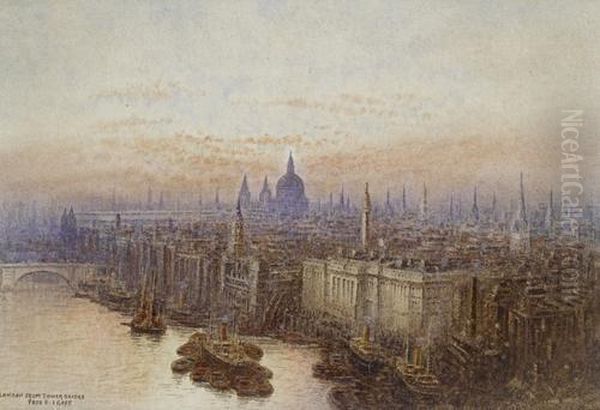
He worked during a time when the legacy of earlier British landscape masters like J.M.W. Turner and John Constable was still potent, providing a foundation in atmospheric effects and naturalistic observation. Simultaneously, the meticulous detail found in some Victorian art, including the work of the Pre-Raphaelites, may have informed his approach to architectural rendering. However, his style generally avoided the high finish and moralizing narratives often associated with mainstream Victorian academic painting.
The Etching Revival, spearheaded by figures like James McNeill Whistler and his brother-in-law Seymour Haden, championed the unique qualities of the etched line and the potential for tonal richness through techniques like selective wiping of the plate (retroussage). Goff's engagement with etching suggests an alignment with this movement's appreciation for the medium's expressive capabilities, allowing him to combine detailed observation with evocative atmospheric effects. His style remained largely representational, distinct from the more abstract or experimental paths taken by later modernists.
It is crucial to distinguish Goff's style from descriptions sometimes erroneously associated with the name, such as "organic, innovative, and constantly changing," reflecting a "continuous present" philosophy. These terms are strongly linked to the American architect Bruce Goff (1904-1982), known for his highly individualistic and eclectic architectural designs. Attributing this style to Frederick John Goff, the landscape painter and etcher, is inaccurate and stems from the confusion surrounding the various individuals named Goff. Frederick John Goff's art belongs firmly within the realm of late 19th and early 20th-century British representational landscape and cityscape traditions.
Representative Works and Themes
While Frederick John Goff may not have produced works as universally recognized as some of his contemporaries, his etchings and watercolors, particularly of London, form a coherent and identifiable body of work. Specific titles might include views such as "St Paul's from the Thames," "Westminster Abbey," "The Houses of Parliament," "Tower Bridge," or various scenes along the embankments and waterways of London. These works capture the city during a period of significant change, documenting its enduring landmarks alongside the bustling river traffic and atmospheric conditions.
His focus extended beyond the grand monuments. He also depicted quieter corners of the city, capturing the character of different neighborhoods, bridges, and street scenes. The Thames was a recurring and central theme, allowing him to explore reflections, light on water, and the interplay between the city's architecture and its vital waterway. These river views often possess a strong sense of atmosphere, whether depicting the crisp light of a clear day, the haze of fog, or the fading light of dusk.
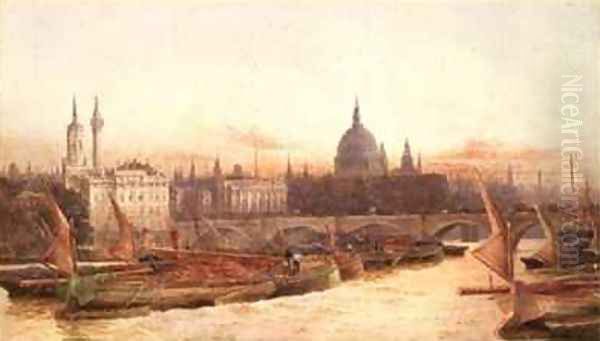
Beyond London, Goff also produced landscapes of other areas, likely including the English countryside and possibly coastal scenes, common subjects for British artists of the period. These works would typically emphasize the picturesque qualities of rural England, featuring cottages, fields, trees, and waterways, rendered with the same attention to detail and atmosphere found in his cityscapes. Watercolors would allow for capturing the nuances of light and color in these settings, while etchings could emphasize structure and tone.
The popularity of etchings during the Etching Revival meant that artists like Goff could produce multiple impressions of their plates, making their work accessible to a broader audience of collectors than unique oil paintings might allow. His works would have appealed to those seeking skilled representations of familiar and cherished locations, captured with artistic sensitivity. While perhaps not groundbreaking in terms of stylistic innovation, his representative works offer valuable visual documents of London and the English landscape at the turn of the 20th century, executed with considerable technical skill.
Context: The Late Victorian and Edwardian Art World
Frederick John Goff practiced his art during a vibrant and complex period in British art history. The late Victorian era (roughly 1870-1901) was dominated institutionally by the Royal Academy of Arts, which held large annual exhibitions setting the standard for mainstream taste. Academic painting often emphasized historical subjects, portraiture, and narrative scenes, executed with a high degree of finish. However, challenges to this establishment were emerging.
The Aesthetic Movement, gaining prominence in the 1870s and 1880s, championed "art for art's sake," prioritizing beauty and sensory experience over narrative or moral content. Figures like James McNeill Whistler, with his tonal harmonies and evocative "Nocturnes," were central to this, often clashing with traditionalists like the critic John Ruskin. Whistler's emphasis on atmosphere and suggestive forms, particularly in his etchings of the Thames, provides an important context for Goff's own London views, even if Goff's style remained more representational.
The influence of French Impressionism began to be felt more strongly in Britain from the 1880s onwards. While initially met with skepticism by the establishment, British artists started absorbing its lessons, particularly the emphasis on capturing fleeting moments, the effects of light and color, and painting en plein air (outdoors). This led to the formation of groups like the New English Art Club (NEAC) in 1886, providing an alternative exhibition venue for artists influenced by French naturalism and Impressionism, such as Philip Wilson Steer and Walter Sickert.
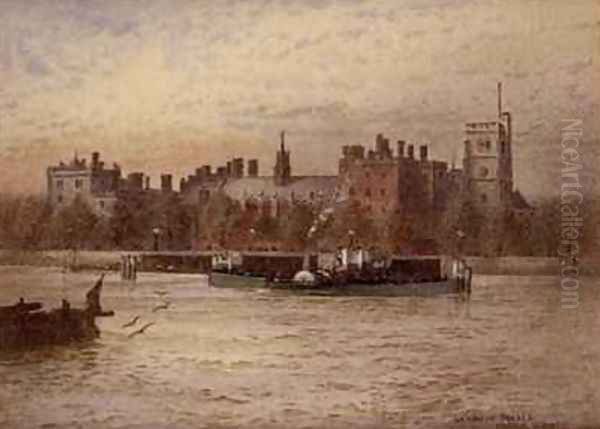
Rural naturalism also flourished, with artists depicting scenes of everyday country life with a focus on realism and atmospheric truth. The Newlyn School in Cornwall, including painters like Stanhope Forbes and Frank Bramley, became known for their depictions of coastal communities and their use of plein air techniques, often employing a square brush technique influenced by French painter Jules Bastien-Lepage. Figures like George Clausen and Henry Herbert La Thangue also explored themes of rural labor and landscape with a naturalistic sensibility.
The Edwardian era (1901-1910) and the subsequent years leading up to World War I saw these trends continue, alongside the arrival of Post-Impressionism, famously introduced to London by Roger Fry's controversial exhibitions in 1910 and 1912. While Goff's work seems largely untouched by these more radical developments, the overall artistic environment was one of diverse styles and competing ideas, ranging from enduring academic traditions to various forms of modernism. Goff navigated this landscape, finding his place within the popular and enduring genre of topographical and landscape art, enhanced by the technical possibilities of the Etching Revival.
Contemporaries and Connections
Situating Frederick John Goff within his time involves recognizing the diverse array of artists working alongside him. While direct records of his interactions might be scarce, his work inevitably existed in dialogue with the prevailing styles and prominent figures of the era. His London etchings, for instance, invite comparison with those of James McNeill Whistler (1834-1903), the American-born artist whose atmospheric depictions of the Thames set a new standard for evocative cityscapes and were central to the Etching Revival. Though Goff's style was generally more detailed, Whistler's influence on depicting urban atmosphere was pervasive.
The towering figure of John Singer Sargent (1856-1925), another American expatriate, dominated portraiture but was also a masterful watercolorist, capturing landscapes and city scenes with dazzling light and fluid brushwork during his travels and later life. His approach to light contrasts with Goff's more linear etching style but reflects the era's engagement with Impressionist techniques.
Among British artists more directly influenced by French Impressionism, Philip Wilson Steer (1860-1942) was a leading figure, known for his atmospheric landscapes and coastal scenes that absorbed the lessons of Monet and Degas. Walter Sickert (1860-1942), initially influenced by Whistler, became a key figure in British modernism, known for his gritty urban scenes and association with the Camden Town Group, moving towards a Post-Impressionist aesthetic.
The French Impressionists themselves were increasingly known in Britain. The works of Claude Monet (1840-1926), with his series paintings exploring light effects on subjects like Rouen Cathedral or the Houses of Parliament (painted during visits to London), Camille Pissarro (1830-1903), and Alfred Sisley (1839-1899), the latter having strong ties to Britain, provided direct examples of Impressionist landscape painting that influenced British artists and collectors.
Within the stream of British realism and naturalism, the Newlyn School artists like Stanhope Forbes (1857-1947) and Frank Bramley (1857-1915) focused on depicting the lives of fishing communities with honesty and atmospheric truth, often painting outdoors. Their commitment to specific locales parallels Goff's focus on London, albeit with different subject matter and stylistic concerns.
George Clausen (1852-1944) and Henry Herbert La Thangue (1859-1929) represented another facet of British art, focusing on rural life and landscapes, often influenced by French plein-air painters like Bastien-Lepage, depicting agricultural labor and the effects of light in the countryside. Even the enduring legacy of earlier watercolorists like Myles Birket Foster (1825-1899), known for his detailed and often sentimental rural scenes, formed part of the backdrop against which later landscape artists like Goff worked. This rich milieu of diverse talents and approaches formed the artistic world in which Frederick John Goff created his views of London and the English landscape.
Goff's Place in Art History
Frederick John Goff occupies a specific niche within the broad landscape of British art from the late 19th and early 20th centuries. He appears not as a radical innovator who dramatically altered the course of art, but as a skilled and dedicated practitioner working within established, yet evolving, traditions. His primary contribution lies in the field of topographical art, particularly his etchings and watercolors of London. In this, he followed a long line of artists who documented the changing face of the capital, but did so with the techniques and sensibilities of his own time.
His engagement with the Etching Revival places him alongside other artists who explored the medium's potential for original expression. His work provided contemporary audiences with well-crafted, atmospheric views of familiar and cherished locations. While perhaps overshadowed in historical narratives by the proponents of Aestheticism, Impressionism, or burgeoning Modernism, artists like Goff fulfilled an important role, creating accessible and accomplished works that captured the character of their environment.
His art serves as a valuable visual record of London and its environs during a period of transition, rendered with technical proficiency and a sensitivity to atmosphere that likely absorbed subtle influences from Impressionism without fully adopting its stylistic tenets. He represents a strand of British art that maintained strong connections to representation and traditional skills while acknowledging the changing artistic climate.
Crucially, assessing his place requires clearly distinguishing him from Frederick R. Goff, the bibliographer, and Frederick H. Goff, the banker and philanthropist. The confusion surrounding the name underscores the importance of precise identification in art historical research. Frederick John Goff's legacy is that of a competent and appealing landscape and cityscape artist, particularly noted for his etchings, whose work offers a window onto the London of his time and reflects the artistic currents of the Etching Revival and the enduring tradition of British topographical art.
Conclusion: A Painter in Perspective
The quest to understand Frederick E.J. Goff highlights the complexities that can arise in art historical inquiry. The initial ambiguity, fueled by the existence of other prominent individuals sharing similar names, necessitates careful differentiation. By setting aside Frederick R. Goff, the expert on early books, and Frederick H. Goff, the pioneer of community foundations, the focus shifts to Frederick John Goff (1855-1931) as the most probable identity of the painter in question.
Frederick John Goff emerges as a capable British artist specializing in landscape and cityscape, particularly known for his etchings and watercolors of London. Working through the late Victorian, Edwardian, and early Georgian periods, his art reflects both the enduring tradition of topographical representation and an awareness of contemporary artistic developments, such as the Etching Revival and the atmospheric concerns heightened by Impressionism. He captured the iconic landmarks and everyday scenes of his city and surrounding areas with skill and sensitivity.
While perhaps not a figure who dramatically reshaped artistic paradigms like contemporaries such as Whistler or Sickert, Goff contributed to the rich tapestry of British art during his time. His work found an audience and offers a valuable visual record, appreciated for its craftsmanship and evocative portrayal of place. Understanding him requires placing him accurately within the context of his time, alongside the diverse array of artists – from Impressionists like Monet and Pissarro to British realists like Forbes and Clausen – who shaped the artistic landscape he inhabited. His career reminds us that art history encompasses not only the revolutionary figures but also the many skilled artists who worked diligently within established genres, capturing their world for contemporary and future viewers.